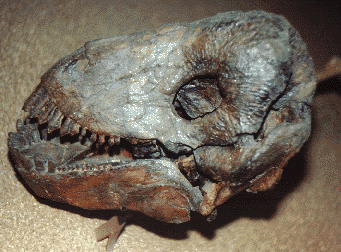
Ulemosaurus
svijagensis -Rjabinin, 1938- skull
Therapsida: Dinocephalia: Tapinocephalidae
Locality:
Isheevo, Tatarstan, eastern European Russia
Age: Late
Permian, 255 million years ago
Meaning of name: "Reptile from the Ulema River"
The
herbivorous dinocephalian Ulemosaurus was obviously similar in its appearance
and
style of life with Estemmenosuchus, but differs from the
latter, in particular,
by the more specialized tooth apparatus.
Both Ulemosaurus
and Estemmenosuchus, unlike mammals, could not chew food
because
of the lack of bony palate, separating the respiratory ducts from the
mouth cavity.
Ulemosaurus was prey to the huge sabre-toothed dinocephalian Titanophoneus,
that
could steal up easily to such a relatively ponderous and constantly grazing prey.
Represented
above is a skull. Several skulls and skeletons of this species were
recovered
from sandstones that appear to represent high energy flood deposits.
The bone
in the skull of this animal was extremely dense.
Like Estemmenosuchus,
this reptile would seem to have been a herbivore.
However, in both cases it has
been suggested by some researchers that these animals
were carnivores, biting
their prey by rapidly slamming the lower jaw shut
against the upper, the teeth
acting as blades.
With the heavy construction of the lower jaw, there would probably
have
been enough momentum to cut flesh in this manner.
Palaeontologists who
regard them as vegetarians point out that their
small side teeth and their front
teeth were evidently adapted for gripping vegetation.
These scientists suggest
that very little food processing went on in the mouth,
but that most took place
in the stomach and intestines.
The teeth were mainly just for gathering the food.
Ulemosaurus was a gigantic animal
with a very thick frontal bone that sometimes
reached 10 cm in thickness.
Some paleontologists think that this was a specialization
for head butting behaviour.





